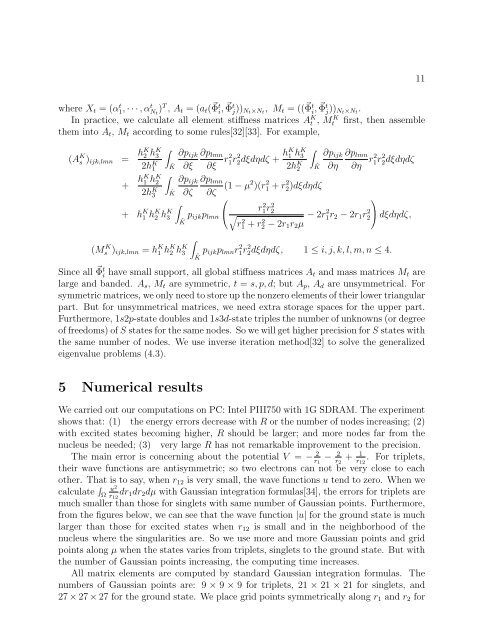Finite element calculations for the helium atom∗ 1 Introduction
Finite element calculations for the helium atom∗ 1 Introduction
Finite element calculations for the helium atom∗ 1 Introduction
You also want an ePaper? Increase the reach of your titles
YUMPU automatically turns print PDFs into web optimized ePapers that Google loves.
where Xt = (α t 1, · · · , α t Nt )T , At = (at( � Φ t i, � Φ t j))Nt×Nt, Mt = (( � Φ t i, � Φ t j))Nt×Nt.<br />
In practice, we calculate all <strong>element</strong> stiffness matrices A K t , M K t first, <strong>the</strong>n assemble<br />
<strong>the</strong>m into At, Mt according to some rules[32][33]. For example,<br />
(A K s )ijk,lmn = hK2 hK 3<br />
2hK �<br />
∂pijk ∂plmn<br />
ˆK 1 ∂ξ ∂ξ r2 1r 2 2dξdηdζ + hK1 hK 3<br />
2hK �<br />
∂pijk ∂plmn<br />
ˆK 2 ∂η ∂η r2 1r 2 2dξdηdζ<br />
+ hK1 hK 2<br />
2hK �<br />
∂pijk ∂plmn<br />
ˆK 3 ∂ζ ∂ζ (1 − µ2 )(r 2 1 + r 2 2)dξdηdζ<br />
+ h K 1 h K 2 h K ⎛<br />
�<br />
r<br />
3 pijkplmn<br />
⎝<br />
ˆK<br />
2 1r2 2<br />
�<br />
r2 1 + r2 2 − 2r1r2µ − 2r2 1r2 − 2r1r 2 ⎞<br />
⎠<br />
2 dξdηdζ,<br />
(M K s )ijk,lmn = h K 1 h K 2 h K 3<br />
�<br />
ˆK<br />
pijkplmnr 2 1r 2 2dξdηdζ, 1 ≤ i, j, k, l, m, n ≤ 4.<br />
Since all � Φ t i have small support, all global stiffness matrices At and mass matrices Mt are<br />
large and banded. As, Mt are symmetric, t = s, p, d; but Ap, Ad are unsymmetrical. For<br />
symmetric matrices, we only need to store up <strong>the</strong> nonzero <strong>element</strong>s of <strong>the</strong>ir lower triangular<br />
part. But <strong>for</strong> unsymmetrical matrices, we need extra storage spaces <strong>for</strong> <strong>the</strong> upper part.<br />
Fur<strong>the</strong>rmore, 1s2p-state doubles and 1s3d-state triples <strong>the</strong> number of unknowns (or degree<br />
of freedoms) of S states <strong>for</strong> <strong>the</strong> same nodes. So we will get higher precision <strong>for</strong> S states with<br />
<strong>the</strong> same number of nodes. We use inverse iteration method[32] to solve <strong>the</strong> generalized<br />
eigenvalue problems (4.3).<br />
5 Numerical results<br />
We carried out our computations on PC: Intel PIII750 with 1G SDRAM. The experiment<br />
shows that: (1) <strong>the</strong> energy errors decrease with R or <strong>the</strong> number of nodes increasing; (2)<br />
with excited states becoming higher, R should be larger; and more nodes far from <strong>the</strong><br />
nucleus be needed; (3) very large R has not remarkable improvement to <strong>the</strong> precision.<br />
The main error is concerning about <strong>the</strong> potential V = − 2 2 1 − + . For triplets,<br />
r1 r2 r12<br />
<strong>the</strong>ir wave functions are antisymmetric; so two electrons can not be very close to each<br />
o<strong>the</strong>r. That is to say, when r12 is very small, <strong>the</strong> wave functions u tend to zero. When we<br />
calculate �<br />
Ω u2<br />
r12 dr1dr2dµ with Gaussian integration <strong>for</strong>mulas[34], <strong>the</strong> errors <strong>for</strong> triplets are<br />
much smaller than those <strong>for</strong> singlets with same number of Gaussian points. Fur<strong>the</strong>rmore,<br />
from <strong>the</strong> figures below, we can see that <strong>the</strong> wave function |u| <strong>for</strong> <strong>the</strong> ground state is much<br />
larger than those <strong>for</strong> excited states when r12 is small and in <strong>the</strong> neighborhood of <strong>the</strong><br />
nucleus where <strong>the</strong> singularities are. So we use more and more Gaussian points and grid<br />
points along µ when <strong>the</strong> states varies from triplets, singlets to <strong>the</strong> ground state. But with<br />
<strong>the</strong> number of Gaussian points increasing, <strong>the</strong> computing time increases.<br />
All matrix <strong>element</strong>s are computed by standard Gaussian integration <strong>for</strong>mulas. The<br />
numbers of Gaussian points are: 9 × 9 × 9 <strong>for</strong> triplets, 21 × 21 × 21 <strong>for</strong> singlets, and<br />
27 × 27 × 27 <strong>for</strong> <strong>the</strong> ground state. We place grid points symmetrically along r1 and r2 <strong>for</strong><br />
11


